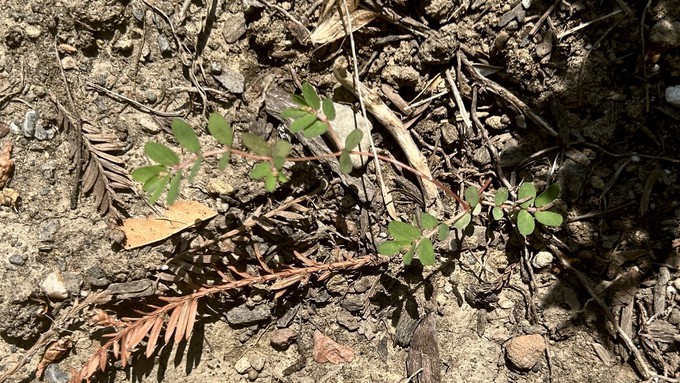
It's a Sisyphean battle, but don't surrender

Spurge is a scourge, spreading through microscopic seeds, but when small it can be dug out easily, unlike some weeds. Kathy Morrison
Not everyone hates weeds, I've discovered. Some gardeners have a "live and let live" attitude about the interlopers that shove their way into the garden, squatting next to the dahlias or cozying up to the tomatoes. Some folks even proclaim the beauty of weeds -- those little white flowers of field bindweed, for example. So pretty!
So dastardly, if you ask me.
Strictly speaking, a weed is any plant that grows where you don't want it. A tree of heaven (Ailanthus altissima) could be classified as a weed under this definition -- they move in unannounced all the time.
But most of us have garden-variety weeds to deal with: dandelions, crabgrass, nutsedge and the like. Lately, a variety of spurge has been our biggest problem -- my husband spent several hours digging it out of the front yard this past week so he could mow our small lawn without chopping the weeds into bits.
Why bother? The weeds ironically did make the lawn look greener. But, ugh, spurge and many other weeds can take over and choke out desirable plants. Which leads me to all the reasons to keep after weeds, as endless as the task may seem:
1) They're thieves. They suck up water, nutrients and sunlight that could be benefitting a garden's intentional plants.
2) They're opportunists. Given a little room to roam or soil to settle in, they develop tap roots, bulblike "nuts" or runners that take off into all corners. And this makes them tougher to remove.
3) They're thugs. Some such as bindweed can climb, envelop and throttle other plants. Others produce burrs that stick to pets or seeds with nasty thorns strong enough to pop a bicycle tire.
4) They can be outright dangerous. Pokeweed, for example, is toxic to humans and livestock -- all parts of it, not just the pretty berries. It's a perennial that produces a massive taproot that will help the plant grow back after winter.
5) They're hiding places for pests. This is why weeds shouldn't be ignored in winter. They can harbor bad bugs that will move into your ornamental or vegetable garden once the weather warms up.
All that said, into every gardener's life some weeds will sprout. It's part of what we get to share complaints about. So be good Earth residents, folks: Don't use broad-spectrum herbicides against those invaders. Mulch your planting beds. Find an excellent weed digging tool and keep at it. It's good exercise, after all.
Note: If you're interested in learning more about weeds, the UC Integrated Pest Management program website (which includes the links above) is invaluable. Also, check out the latest edition of the UCIPM Home and Garden Pest Newsletter. It includes an article "How can weed control help with wildfire preparedness?" Yes -- a sixth reason to keep after weeds: They can dry out in summer and become easy fuel for fires.
Comments
0 comments have been posted.Sacramento Digs Gardening to your inbox.
Food in My Back Yard Series
April 29: What's (already) wrong with my tomato plants?
April 22: Should you stock up on fertilizer? (Yes!)
April 15: Grow culinary herbs in containers
April 8: When to plant summer vegetables
April 1: Don't be fooled by these garden myths
March 25: Fertilizer tips: How to 'feed' your vegetables for healthy growth
March 18: Time to give vegetable seedlings some more space
March 11: Ways to win the fight against weeds
March 4: Potatoes from the garden
Feb. 25: Plant a fruit tree now -- for later
Feb. 18: How to squeeze more food into less space
Feb. 11: When to plant? Consider staggering your transplants
Feb. 4: Starting in seed starting
Sites We Like
Garden Checklist for week of May 4
Enjoy this spring weather – and get gardening!
* Plant, plant, plant! It’s prime planting season in the Sacramento area. Time to set out those tomato transplants along with peppers and eggplants. Pinch off any flowers on new transplants to make them concentrate on establishing roots instead of setting premature fruit.
* Direct-seed melons, cucumbers, summer squash, corn, radishes, pumpkins and annual herbs such as basil.
* Harvest cabbage, lettuce, peas and green onions.
* In the flower garden, direct-seed sunflowers, cosmos, salvia, zinnias, marigolds, celosia and asters. (You also can transplant seedlings for many of the same flowers.)
* Plant dahlia tubers. Other perennials to set out include verbena, coreopsis, coneflower and astilbe.
* Transplant petunias, marigolds and perennial flowers such as astilbe, columbine, coneflowers, coreopsis, dahlias, rudbeckia and verbena.
* Keep an eye out for slugs, snails, earwigs and aphids that want to dine on tender new growth.
* Feed summer bloomers with a balanced fertilizer.
* For continued bloom, cut off spent flowers on roses as well as other flowering plants.
* Add mulch to the garden to maintain moisture. Mulch also cuts down on weeds. But don’t let it mound around the stems or trunks of trees or shrubs. Leave about a 6-inch to 1-foot circle to avoid crown rot or other problems.